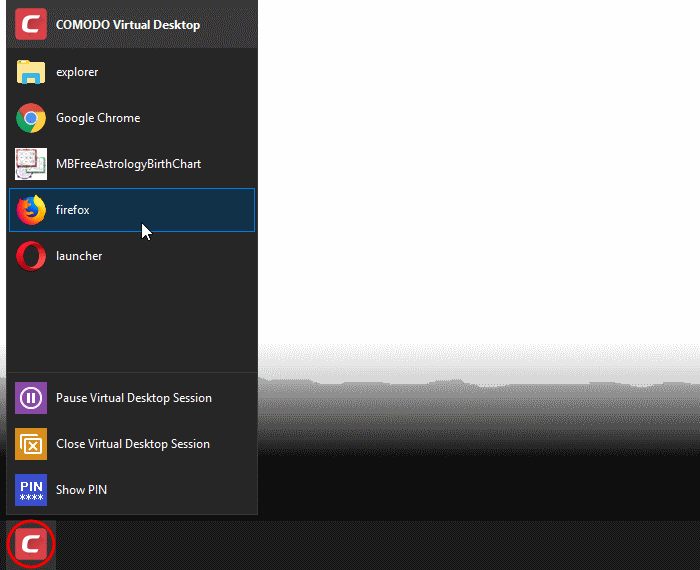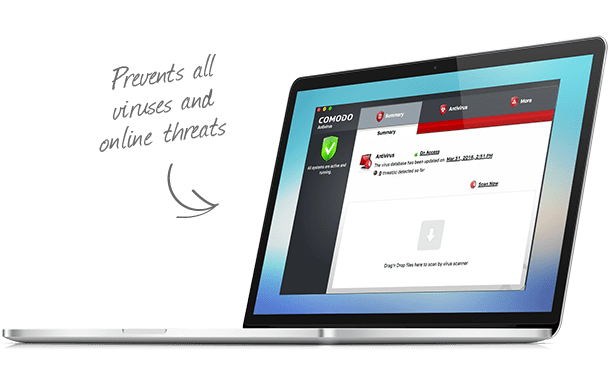Comodo Antivirus or Comodo Internet Security (CIS) comes equipped with impressive security features like Default Deny Approach, Containment, Host Intrusion Prevention System (HIPS), Viruscope and more offers solid Mac protection from different kinds of malware and other security threats. The answer to the question, 'how to remove malware from. All these alternative software of COMODO Internet Security which can be the best option for the OS like Window, Mac or Linux for downloading. This is a user-friendly COMODO Internet Security alternative software that you can install it everywhere like in your Android, and iOS. Wifi Security: for securing your wifi connections, especially when using public wifi(s). Comodo Security products (be it antivirus or Comodo Internet Security (CIS)) backed by their innovative technology offer solid protection for your PC(s). Therefore buy them and protect your PC(s) against various forms of security threats.
- Introduction To Comodo Client - Security For MAC
- The Summary Screen
- Antivirus Tasks - Introduction
- Scanner Settings
- More Options - Introduction
- Preferences
- Manage My Configurations
- View Logs
- Antivirus Logs
- Alerts Displayed Logs
- Tasks Launched Logs
- Configuration Change Logs
- Appendix 1 - CCS For Mac How To Tutorials
Install Comodo Client - Security for MAC
You can use the Endpoint Manager (EM) interface to deploy Comodo Client Security (CCS) to your endpoints. You can purchase EM as stand-alone application or as a part of the ITarian platform.
This section covers how to:
Subscribe for Endpoint Manager
You can purchase Endpoint Manager as stand-alone application or as part of the ITarian suite:
- ITarian - Sign up for ITarian athttps://www.itarian.com/signup/
- After sign-up, login to the portal then click 'Applications > 'Endpoint Manager'.
- Stand-alone Endpoint Manager

- Visit https://secure.comodo.com/home/purchase.php?pid=98&license=try for the trial version orhttps://secure.comodo.com/home/purchase.php?pid=98 for the full version.
- After sign-up, you can access your Endpoint Manager at the URL provided during setup.
Enroll Users
You must add users to Endpoint Manager before you can install CCS on your endpoints.
- ITarian MSP customers - You can create multiple companies and can enroll users to any of them.
- ITarian Enterprise, and stand-alone Endpoint Manager customers - All users are enrolled to the default company.
Add a user
- Open Endpoint Manager
- Click 'Users' > 'User List'
- Click 'Create User'
or
- Click the 'Add' button on the menu bar and choose 'Create User'.
The create user form will open:

- User Name - Enter the login username of the user. They will appear under this name in the EM interface.
- Email - Account and device activation mails will be sent to this address.
- Phone Number - The contact number of the user.
- Company - The organization to which you want to add the user.
Role
A 'role' determines user permissions within the Endpoint Manager console itself. Endpoint Manager ships with two default roles:
- Administrator - Full privileges in the Endpoint Manager console. The permissions for this role are not editable.
- User - In most cases, a user is simply an owner of a managed device. They should not require access to the Endpoint Manager console. Under default settings, users cannot login to Endpoint Manager.
- Click 'Submit' to add the user to Endpoint Manager.
A confirmation message is shown:
- Repeat the process to add more users
- New users are added to the 'Users' interface (click 'Users' > 'User List')
Tip: You can also import a list of users from a .csv file, and bulk enroll users/endpoints from Active Directory (AD). See https://help.comodo.com/topic-399-1-786-10125-Create-New-User-Accounts.html if you want to learn more about these options. |
Enroll Devices
The next step is to add user devices so you can manage them with Endpoint Manager.
Enroll devices
- Click 'Users' > 'User List'
- Select users for whom you want to enroll devices
- Click the 'Enroll Device' button above the table
Or
- Click the 'Add' button at the menu bar and choose 'Enroll Device'.
This starts step 1 of the device enrollment wizard:
Step 1 - Device Options
- Current device - Enrolls the device you are currently using. You may disregard this option at this stage as we are adding multiple devices with the 'Other device' option.
- Other device - Add devices owned by the users you selected previously. Those users should already be listed in the 'Specify User' box:
- You can add additional, existing users by simply typing their email address in the box. Endpoint Manager will auto-suggest users that have already been created.
- Create New User - Click if you want to add a new user to Endpoint Manager. You cannot add devices unless you have first added the users that own them.
- Click 'Next' to proceed to step 2.
Step 2 - Enrollment Options
Enrollment Type
Applies to Windows, Mac and Linux devices.
- Enroll and Protect - Installs both the communication client and the security client.
Comodo Internet Security Cnet
- Just Enroll - Installs only the communication client
Background. There are two types of client:
- Communication Client - Connects the device to Endpoint Manager for central management. It is mandatory to install this client.
- Security Client - This is the security software. Depending on the operating system, it includes antivirus, firewall, threat-containment, web-filtering, and more. It is optional to install this client.
Comodo Internet Security Complete
TLDR - ‘Not specified’ only installs the communication client so the device can connect to Endpoint Manager. It does not install the security client. Click one of the operating system tiles if you also want to install the security client.
Option 1 - Enroll + Protect - Single Operating System
- Choose this if you want to deploy both communication and security clients
- Click the Mac OS box. Please make sure all your target devices use this operating system.
- The wizard will send enrollment mails which only contain download links for the Mac clients.
- You can customize enrollment options as required. You can configure items such as enrollment type, MDM profile and device name.
- Note - Please uninstall any other antivirus products from target endpoints before proceeding. Failure to do so could cause conflicts that mean CCS does not function correctly.
Option 2 - Enroll Only - Multiple Operating Systems
- Choose this if you only want to deploy the communication client. If required, you can install the security client later after enrolling the endpoint
- Click 'Devices' > 'Device List'
- Select the target devices
- Click the 'Install or Update Package' button > Choose 'Install Comodo Client – Security'.
Click 'Next' to skip to step 3 if you are happy with your choices thus far.
OR
See the table below for more information about the options on this page.
Setting | Description |
|---|---|
Select Method |
|
Device Name Options |
|
- Click 'Next' to proceed to step 3
Step 3 - Installation Summary
Review your choices so far.
- Click ‘Back’ or 'Change Configuration' (top-right) to revise your choices.
- Click 'Next' to proceed to step 4
Step 4 - Installation Instructions
The final step is to send out the enrollment emails to the device owners:
- Send To Email - Click this to send enrollment mails to users with the settings you choose in steps 1 - 3.
- Enroll Another Device - Takes you back to step 1
- Go to Bulk Installation Package - Takes you to bulk installation package screen to configure and enroll users in bulk. See 'Bulk Enrollment of Devices'
- Click 'Finish' to close the window.
An example mail is shown below:
The user experience is as follows:
- User opens the email on the Mac endpoint you want to enroll.
- Click the enrollment link in the email to open the device enrollment page
- Click the 'Download macOS Installer' button:
Comodo Internet Security Cis
Comodo Internet Security Suite
- The EM client setup file gets downloaded.
- Run the setup file to install the client on the endpoint.
- The device is automatically added to Endpoint Manager once installation is complete. The EM communication client icon appears at the top-right of the endpoint screen.
- Protection is effective immediately after the computer restarts.
An Endpoint Manager (EM) security profile is applied to the device.
- If the user is already associated with a configuration profile in EM, then those profiles will be applied to the device. See Assign Configuration Profile(s) to User Devices and Assign Configuration Profiles to a User Group for more details.
- If no profiles are defined for the user then the default Mac profile(s) will be applied to the device. See Manage Default Profiles for more details.
The device can now be remotely managed from the EM console.
- Introduction To Comodo Client - Security For MAC
- The Summary Screen
- Antivirus Tasks - Introduction
- Scanner Settings
- More Options - Introduction
- Preferences
- Manage My Configurations
- View Logs
- Antivirus Logs
- Alerts Displayed Logs
- Tasks Launched Logs
- Configuration Change Logs
- Appendix 1 - CCS For Mac How To Tutorials
Comodo Client - Security (CCS) for MAC offers complete protection against viruses, worms and Trojan horses for MAC OS X based computers. The software is easy to use and features real-time virus monitoring, full event logs, cloud-based analysis of unknown files and more.
- To run a virus scan, click the 'Scan Now' link on the summary screen.
- To scan individual items:
- Drag them into the scan box in the 'Summary' area
OR
- Drag them onto the Comodo dock icon
Features at a glance
Comodo Internet Security Mac Os
- Detects, blocks and eliminates viruses from desktops and networks

- Constantly protects you with real-time and on-access scanning
- Scheduler allows you to run scans at a time that suits you
- Automatically runs unknown files inside a secure container which is isolated from the rest of your computer
- Daily, automatic updates of virus definitions
- Simple to use: install and forget while CSS protects you in the background
Comodo Internet Security Complete 11
Guide Structure
This guide explains the basic usage of CCS to Endpoint Manager admins and end-users.
- Start CCS
- View Logs
Comodo Internet Security Mac Os
- Scan your Computer for Viruses
